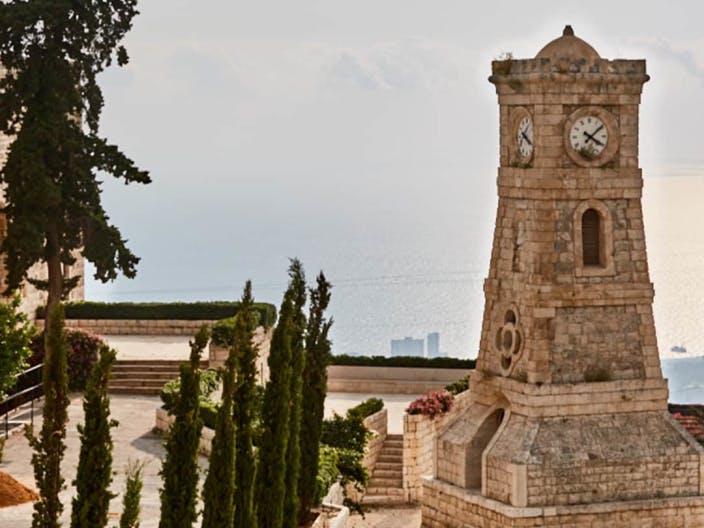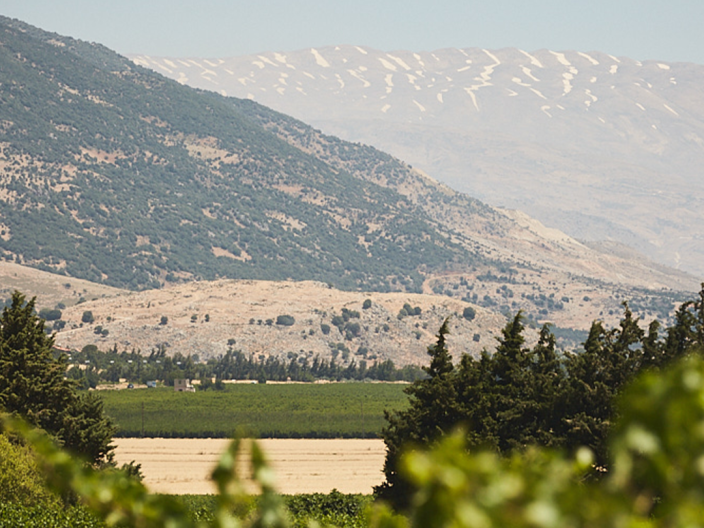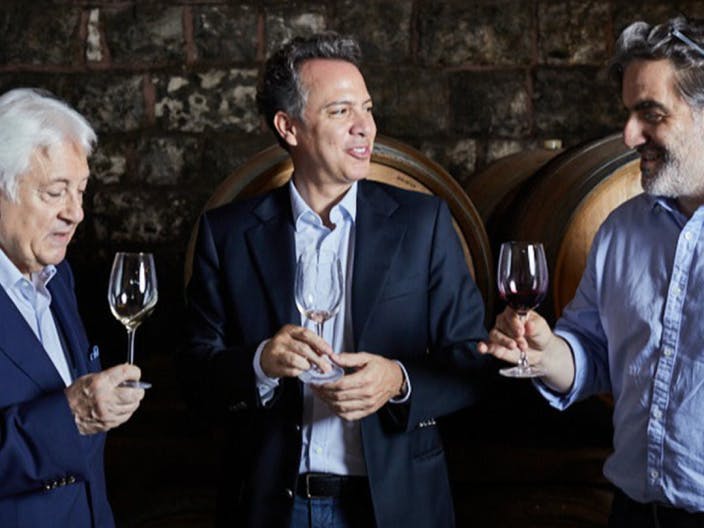In the vineyard
Musar's vineyards have historically been sited in a string of villages on the western side of the Beka'a Valley - Ammiq, Aana and Kefraya. Aana's vineyards are notable for their deep soils with patches of silt, clay and gravel over limestone, making the perfect base for Cinsault and Grenache grapes.
And Kefraya's vineyards for lighter stony soils over a base of limestone: these are the prize vineyards, perfect for Carignan, Cabernet Sauvignon and particularly for Cinsault. "Wine from Kefraya has a certain elegance and finesse; it adds complexity to the blend, where Aana adds depth and structure," explains Gaston Hochar.
Musar’s indigenous Lebanese white grape varieties are grown separately in the Beka’a. Obaideh thrives in the chalky foothills of the east side of the valley, in the village of Ain Arab. The Obaideh grape is structured and elegant, and offers the perfect counterpoint to its very powerful blend-partner, Merwah, which is planted back in the calcareous gravels of Mount Lebanon. These ungrafted vines – some of them new plantings, some ancient – grow in a phylloxera-free zone, which gives them a satisfying Lebanese authenticity as well as their own strong lemon-zest and mineral personality.
The striking thing about the Hochar vines is that they at first seem to be grown in exactly the way they were back in Phoenician times, some 6,000 years ago. Hochar vines are allowed the freedom to grow as bush vines. The vineyards are also organic, as told by the heady hum of bee-life and constant chirrup of birds. The sound of life buzzing, and the mix of wild oats and herbs that springs up between the vines (later ploughed back into the soil to act as a fertilizer and moisture trap) all add to the sense of enormous vinous well-being.
Winemaker and viticulturalist Tarek Sakr (who joined Chateau Musar in 1991, aged 23, having studied oenology in France and trained at Château Lafite Rothschild) explains how the density at which the vines are planted has a huge bearing on the quality of fruit they produce. "We started with 2.5 metres between the rows and the vines, but the soils at Aana are richer so I got too much growth. I needed more density. So now we have 1.25 metre spacing all through. We changed from 1,600 vines per hectare to 3,200; this way we use our soil in a better way and we don’t need to green harvest." Hochar vines yield an impressively low 15–35 hectolitres per hectare of high quality fruit.
In the winery
Winemaking takes place at the Hochars’ modern-day facility, built by Gaston Sr in 1958. Dug into the side of Mount Lebanon, the building is large and functional, constructed from sturdy, biscuit coloured cubes of limestone: four levels for the winery, and two at the top for the family’s apartments (where they sheltered from the bombing in Beirut, 1975–1990).
Some wineries will leave stems on the grape bunches for extra tannin, but at Musar Gaston and Tarek follow Serge’s principle that these tannins are too bitter. Otherwise, the wines are very much left to their own devices. "Fermentation occurs naturally, with natural yeast, nothing added," says Gaston. "We have been making wine this way for over 60 years."
THE RED WINES
Natural yeasts, neutral concrete vats and low ambient temperatures enable a gentle transformation from juice to wine. It all happens at 20-26˚C and takes seven to 10 days, depending on the will of the vintage. Extraction varies depending on the year, the grape and the wine being made. "It could be a week, three days or 10 days," he says. The wine matures in barrels made of Nevers French oak (around 10% new) for a year, it is then drawn out into concrete vats ready for blending.
The Hochars’ finest wine, their grand vin, is 'Chateau Musar’ (or simply ‘Chateau’ as it is affectionately known). For this, Cinsault, Carignan and Cabernet Sauvignon are the grapes used, from the vineyards of Kefraya. The parcel or plot of vines the grapes come from will be different for every vintage although the proportion of each grape in the final blend will be roughly thirds.
There are few other wineries in the world that dare (or can afford) to wait so long before releasing their wines to market. Most wineries need to sell their wines young to keep the finances healthy. But at Musar, time is a huge factor in shaping the eventual character of the wine; so much so that it will not be released until seven years of age, when its mature flavours show the very first signs of emerging. Chateau Musar is said by many (the Hochars included) to be at its best from 12 to 15 years of age.
THE WHITE WINES
Chateau Musar’s white wine is unique. Serge Hochar was the first winemaker to recognise the blending possibilities of Lebanon’s native Obaideh and Merwah grapes. As Serge said: "My white is not understood. It is bigger than my red wine; it goes with more foods and it is more serious. But it is also more difficult. One day people will come to it." And they should. In the winery, the grapes are destemmed, pressed, removed from the skins and transferred to oak barrels for fermentation (at 20-25˚C). So far so usual. But where some winemakers might block the malolactic or secondary fermentation in order to retain a certain crispness and acidity in their wine, the Hochars believe in a more Burgundian approach, allowing the process to occur naturally, using the bacteria naturally present on the grapes (just as they do with the first fermentation) thus helping the wine to become richer and smoother. "We do not block the malo because our phenological profile doesn’t allow it. If we were to block malo we would have to use high levels of sulphur, which we are against," says Gaston: "We do not choose to control our wines in this way." As with the reds, the evolution of Musar’s white wines is left to Mother Nature.
The 'Musar Blanc' blend comprises 60% Obaideh grapes and 40% Merwah, each barrel-fermented then aged for nine months in oak casks. The wines are blended within one year, then bottled and stored for seven in the mountainside cellars before they are released.


